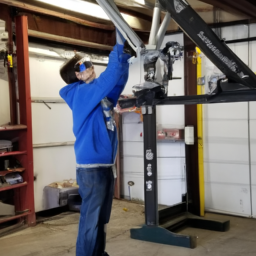
In this article, you will learn about the essential safety measures you need to take when operating a garage hoist. Whether you are a professional mechanic or a DIY enthusiast, it is crucial to prioritize safety to avoid accidents and injuries. By following these guidelines, you can ensure a safe and smooth operation of your garage hoist.
First and foremost, always read and understand the manufacturer’s instructions and safety guidelines before operating the hoist. Familiarize yourself with the equipment, including its features, limitations, and recommended usage. Make sure the hoist is properly installed and maintained, and regularly inspect it for any signs of wear or damage. Additionally, always wear appropriate personal protective equipment, such as gloves and safety goggles, to protect yourself from potential hazards. Finally, never exceed the weight capacity of the hoist and ensure that the load being lifted is secure and balanced to avoid any accidents. Operating a garage hoist can be a convenient and efficient way to lift vehicles for repairs or maintenance. However, it is essential to prioritize safety during the operation to minimize the risk of accidents or injuries. By following these safety measures, you can ensure a safer working environment for yourself and others.
Inspecting the Hoist
Before you begin using the hoist, it is crucial to inspect it for any visible damages or signs of wear and tear. Look out for any cracks, frayed cables, or loose bolts. These issues can compromise the stability and safety of the hoist, and it is essential to address them before use.
Checking for any visible damages
Inspect the hoist’s structure thoroughly, paying particular attention to components such as the frame, beams, and hydraulic legs. Look for any signs of corrosion, which can weaken the integrity of these parts. If you notice any significant damages, contact a professional to assess and repair them before using the hoist.
Examining the cables and chains
Inspect the cables and chains for any signs of fraying, kinks, or slackness. These issues can compromise the hoist’s lifting capability and pose a safety hazard. If you notice any damages or abnormalities, it is best to replace them immediately.
Testing the emergency stop button
The emergency stop button is an essential safety feature of the hoist. It allows you to halt the operation quickly in case of an emergency. Test this button regularly to ensure it is in working condition and easily accessible during an emergency.
Clearing the Area
Creating a safe working environment is crucial when operating a garage hoist. Clearing the area of any obstacles, debris, or flammable materials is essential to prevent accidents and ensure smooth operation.
Removing any obstacles or debris
Before operating the hoist, ensure that the area is free from any clutter or obstructions. Remove tools, equipment, or any loose items that may pose a tripping hazard or fall onto the hoist during operation. Clearing the area allows for a smooth and safe lifting process.
Ensuring there are no flammable materials nearby
Garage hoists commonly operate using hydraulic power, which involves storing and transmitting fluids under high pressure. To prevent the risk of fire or explosion, ensure that there are no flammable materials or substances in the vicinity of the hoist.
Keeping the work area well-lit
Adequate lighting is essential for a safe working environment. Proper illumination ensures that you can see the hoist and the vehicle clearly during operation. Inadequate lighting can lead to accidents or incorrect positioning of the vehicle on the hoist.
Using Personal Protective Equipment
Personal protective equipment (PPE) plays a crucial role in ensuring operator safety when operating a garage hoist. Wearing appropriate PPE protects you from potential hazards and the risk of injuries.
Wearing safety goggles and gloves
Safety goggles and gloves are essential for protecting your eyes and hands from potential debris, chemicals, or sharp objects. Wear these PPE items whenever you are operating the hoist or working on a vehicle while it is on the hoist.
Using a hard hat for head protection
Your head is vulnerable to injuries from falling objects or bumping into overhead structures. Wearing a hard hat provides protection and reduces the risk of head injuries when operating the hoist.
Avoiding loose clothing and jewelry
Loose clothing, such as long sleeves or baggy pants, can become entangled in the hoist’s moving parts or the vehicle being lifted. Avoid wearing loose clothing or accessories like jewelry that can get caught and pose a safety hazard.
Properly Positioning the Vehicle
Correctly positioning the vehicle on the hoist is crucial for maintaining stability and preventing accidents or damage to the vehicle.
Engaging the parking brake
Before lifting the vehicle, always engage the parking brake to ensure that it does not move during the lifting process. This prevents any unexpected movement of the vehicle and minimizes the risk of accidents.
Ensuring the vehicle is balanced on the hoist
Proper vehicle positioning is essential for maintaining stability and preventing the vehicle from tipping over. Ensure that the vehicle is placed evenly on the hoist, and its weight distribution is balanced. This helps prevent excessive stress on the hoist and maintains a safe working environment.
Avoiding overloading the hoist’s weight capacity
Every garage hoist comes with a weight capacity limit that should never be exceeded. Make sure to check the hoist’s specifications and ensure that the vehicle’s weight falls within the allowed limit. Overloading the hoist can lead to structural failure and pose serious risks to everyone involved.
Operating the Hoist Safely
Operating the hoist safely requires following proper procedures and using the hoist’s controls judiciously. By doing so, you can maintain control over the equipment and minimize the risk of accidents.
Following the manufacturer’s instructions
Read and understand the manufacturer’s instructions and guidelines for operating the hoist. Familiarize yourself with the hoist’s controls and ensure you know how to stop or reverse the operation if needed.
Using the hoist’s controls carefully
Operate the hoist’s controls smoothly and avoid abrupt or jerky movements that can destabilize the hoist or the vehicle being lifted. Use gradual movements to increase or decrease elevation and ensure a safe and controlled lifting process.
Avoiding sudden movements or jerks
Sudden movements or jerks can put excessive stress on the hoist’s components and compromise its stability. Operate the hoist with care, avoiding abrupt stops or changes in movement that can jeopardize the safety of the operation.
Regular Maintenance and Inspection
Regular maintenance and inspection are essential for ensuring the hoist’s continued reliability and safe operation. By performing routine checks and servicing, you can identify and address any potential issues before they escalate.
Cleaning and lubricating the hoist regularly
Clean the hoist regularly to remove any accumulated dirt, debris, or hydraulic fluid leaks. Additionally, lubricate the moving parts as recommended by the manufacturer to ensure smooth operation and minimize friction.
Inspecting and replacing worn-out parts
Perform regular inspections of the hoist’s components, including cables, chains, pulleys, and hydraulic systems. Look out for signs of wear and tear, corrosion, or damages. Replace any worn-out or faulty parts promptly to maintain the hoist’s safety and efficiency.
Scheduling professional inspections and servicing
In addition to regular maintenance tasks, it is essential to schedule professional inspections and servicing. A certified technician can thoroughly inspect the hoist, identify potential issues, and perform any necessary repairs or adjustments. This ensures that the hoist operates safely and reliably.
Emergency Preparedness
Preparing for emergencies is crucial to mitigate potential risks and ensure the safety of everyone involved in the garage hoist operation.
Knowing how to use the emergency stop button
Familiarize yourself with the location and operation of the emergency stop button. In case of an emergency, such as a malfunction or an accident, knowing how to stop the hoist immediately can prevent further damage or injuries.
Having a fire extinguisher nearby
In the event of a fire, having a fire extinguisher readily available can help suppress or extinguish small fires. Ensure that the fire extinguisher is in good working order and that you know how to use it effectively.
Having a first aid kit readily available
Accidents or injuries can occur even with proper safety measures in place. Having a well-stocked first aid kit nearby ensures that you can administer immediate first aid in case of an emergency.
Training and Education
Proper training and education are essential for safe operation of the garage hoist. By understanding the equipment’s potential risks and hazards, you can take necessary precautions and prevent accidents.
Undergoing proper training on hoist operation
Before using a garage hoist, undergo thorough training on its operation, safety procedures, and maintenance guidelines. Training ensures that you understand the equipment’s capabilities and limitations, enhancing your ability to operate it safely.
Staying updated on safety procedures
Safety procedures and regulations evolve over time, and it is crucial to stay updated on any changes or new recommendations. Regularly review safety guidelines, attend refresher training courses, and stay informed about best practices for operating the hoist.
Understanding potential risks and hazards
Educating yourself about potential risks and hazards associated with operating a garage hoist can help you identify and address safety concerns proactively. By recognizing potential risks, you can take the necessary precautions to prevent accidents or injuries.
Keeping a Clean and Organized Workshop
Maintaining a clean and organized workshop environment is essential for safe and efficient operation of a garage hoist.
Organizing tools and equipment
Ensure that tools and equipment are organized and stored properly. Arrange them in designated areas to prevent tripping hazards and avoid cluttering the workspace. This promotes a safer working environment and enables easy access to required tools.
Maintaining a clutter-free environment
Clean up any spills or debris from the workshop floor promptly. A clutter-free environment minimizes the risk of accidents and tripping hazards during the height-adjustment process.
Implementing proper waste management
Dispose of waste materials, such as oil containers, rags, or scrap metal, in designated containers. Implementing proper waste management practices ensures a safe and clean working environment, reducing the risk of accidents or spills.
Conclusion
Operating a garage hoist can be a convenient and efficient way to lift vehicles for repairs or maintenance. However, it is essential to prioritize safety at all times. By following the safety measures outlined in this article, you can minimize the risks associated with operating a garage hoist and ensure a safer working environment for yourself and others. Always remember to inspect the hoist, clear the area, use personal protective equipment, properly position the vehicle, operate the hoist safely, conduct regular maintenance and inspection, be prepared for emergencies, undergo proper training and education, keep a clean and organized workshop, and stay updated on safety procedures. Your commitment to safety will create a secure environment and make your garage hoist operation a smooth and accident-free process.









